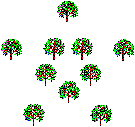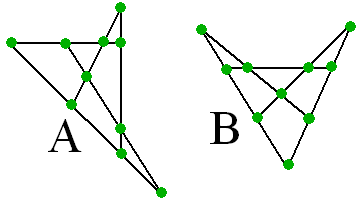1713
points
Questions
215
Answers
287
-
The logic puzzle can be solved by letting the letters N, M, B, L, and E represent the neutrophil, monocyte, basophil, lymphocyte, and eosinophil, respectively. From Clue 1 we know that L is to the right of B; this is the sequence BL. Clue 2 tells us that NM is another sequence. Clue 3 only allows the sequences LE and EL, but EL is not possible because of Clue 1. Combining BL and LE, we now have the sequences BLE and NM. From Clue 3 we know that E is not adjacent to N, therefore the sequence of the lymphocytes is NMBLE.
The white cells are: 1) neutrophil, 2) monocyte, 3) basophil, 4) lymphocyte, 5) eosinophil. The background shows some erythrocytes (red blood cells) which have no nucleus.
Microscopic blood analysis can be very useful for identifying or diagnosing many types of diseases such as anemia, malaria, syphilis, heavy metal poisoning, leukemia, appendicitis, etc.
Leukocytes are the first line of defense of the immune system. Leukocytes are derived from bone marrow stem cells and have three main categories: Lymphocytes, Phagocytes, and Auxiliary Cells. Neutrophils, basophils, and eosinophils are called granulocytes because they have granules in their cytoplasm.
- 4459 views
- 1 answers
- 0 votes
-
Food labels have a lot of technical information that is hard to interpret. We will compare the nutrition labels of raw sunflower seeds from two stores to try to figure out the differences. Weight ratios of fat, carbohydrate, and protein of 2:1:1 to 3:1:1 are very typical for nuts and oil seeds.
The most obvious discrepancy in these labels is the serving size of 28g for the Whole Foods seeds vs. 33g for the Trader Joe’s seeds, both of which have 190 Calories per serving. It is unlikely that a five-gram (15%) difference in the serving size would have a negligible effect on the total calories. We also notice that the Whole Foods seeds have three times the amount of fiber as the Trader Joe’s seeds, and Trader Joe’s seeds have no sugars whereas the Whole Foods seeds have 1 gram of sugars. Aren’t all sunflower seeds the same? How reliable are these “Nutrition Facts”?
Let us start with a simple check to see if everything adds up. The Whole Foods serving size is 28g, but if we add 17g of fat, 6g of carbohydrate, and 7g of protein the total is 30g. Oops! It is not unusual for the sum of the components to be slightly different than the whole due to rounding errors and unlisted components, but it is abnormal to have the components exceed the total serving size by 2 grams (7%).
The Trader Joe’s serving size is 33g. Adding 16g of fat, 8g of carbohydrate, and 8g of protein we get 32g. This is much more consistent and the discrepancy is probably due to rounding. If we had 16.3g of fat, 8.4g of carbohydrate, and 8.3g of protein everything would add up properly, but by rounding to whole numbers we would lose 3% precision.
How about the Calories? Fat has 9 Calories per gram, and protein and carbohydrate have 4 Calories per gram. Fiber contributes no calories because it cannot be digested, so we subtract the grams of fiber from the total carbohydrate. The remaining carbohydrates consist of sugars and starches. The Whole Foods seeds have 9×17 + 4×(6-3) + 4×7 = 193 Calories. The Calories from fat are 9×17 = 153. By rounding to the nearest ten, we get 190 total Calories and 150 Calories from fat in perfect agreement with the label.
Trader Joe’s seeds have 9×16 + 4×(8-1) + 4×8 = 204 Calories. The Calories from fat are 9×16 = 144. By rounding, we get 200 total Calories and 140 Calories from fat. Oops! Something is inconsistent. The total Calories calculated from the components is 5% larger than stated on the label, and the Calories from fat calculated from the components is 6% lower than on the label.
The % Daily Values are based on a U.S. government recommendation that 30% of the Calories should be from fat, 55% from carbohydrates, and 15% from protein. For a 2000-Calorie diet, this is equivalent to 67g of fat, 300g of carbohydrate that includes 25g of dietary fiber, and 75g of protein per day. The dietary fiber for the Whole Foods seeds should be 3×100/25 = 12% instead of 13%. Trader Joe’s Total Fat should be 16×100/67 = 24% instead of 25%, and the dietary fiber value should be 1×100/25 = 4% instead of 5%. These differences are not significant.
- 5297 views
- 1 answers
- 0 votes
-
To solve this problem, it is necessary to know that the gravity of the earth accelerates objects at a rate of 9.8 meters per second squared and then use the laws of gravitation formulated by Isaac Newton (1642-1727).
The distance that an object travels under constant acceleration is given by the formula:
distance = 1/2 × acceleration × time2 + intial speed × time
The initial speed is zero because the balls are dropped and not thrown. Therefore, we can solve for time:time2 = (2 × distance) / acceleration
Substituting distance = 54 meters and acceleration = 9.8 meters/second2, we gettime2 = (2 × 54 meters) / (9.8 meters/second2) = 11.0 seconds2
The square root gives:time = 3.3 seconds
- 4100 views
- 1 answers
- 0 votes
-
The plants are: 1) eggplant, 2) tomato, 3) spearmint. You can learn this and much more by planting a garden and by visiting plant nurseries.
Gardening can teach us about the natural rhythms of life. A well-tended garden can provide us with greenery, flowers, and fruits. If we do not pay attention to the needs of our plants, they will wither and die or become infested with plagues. A beautiful garden is a testament to our awareness of nature.
- 4034 views
- 1 answers
- 0 votes
-
The farmer planted the ten trees in the shape of a star to get five rows of four trees.

This problem has several answers. Reader qc1okay provided diagram A, below. Diagram B is a more symmetrical variation of that idea.

- 4509 views
- 1 answers
- 1 votes
-
The decrease of water content from 99% to 98% may seem insignificant, but it reduces the weight of the fruit by 50%. The 1% decrease in water content of the fruit should not be confused with a 1% decrease of the total amount of water, which would indeed be small.
The cost of the berries is: 100 pounds × $2.00/pound = $200.00
The first day sale of berries with 99% water is: 50 pounds × $4.00/pound = $200.00. The vendor covers his cost on the first day, but does not make a profit.
On the second day, the berries have a water content of 98%. The weight of the dehydrated berries can be calculated as follows:
The leftover 50 pounds of berries with 99% water have 1% of non-water components which weigh 0.5 pound (50 pounds × 1/100 = 0.5 pounds).
When the berries dehydrate, the weight of the non-water component is still 0.5 pounds but it now comprises 2% of the total weight of the dehydrated fruit with the other 98% being water. The weight, W, of the dehydrated fruit can be calculated as follows:
0.5 pounds = W pounds
2% 100%W = (0.5×100)/2 = 25 pounds
What used to be 50 pounds of berries with 99% water content are now 25 pounds of berries with 98% water content.
The second day sale of berries with 98% water is: 25 pounds × $4.00/pound = $100.00. The profit is the total sales ($300.00) minus the cost ($200.00). The vendor had a $100.00 Dollar profit. The loss of water is also a loss of profits. This is why supermarkets spray water on fresh vegetables and keep produce refrigerated.
Dehydration is illustrated graphically with 100 cells, where each o represents water and x represents the non-water portion. The x is only 1% of the total number of cells, but 2% of the bottom 50 cells (highlighted in red). The 50 black o‘s represent water lost by dehydration.
- 4803 views
- 1 answers
- 0 votes
-
This problem gives the illusion of guessing an unknown number, but the unknown has been cancelled mathematically.
( X + 7 – 2 – X ) × 4 – 2 = 18- 7712 views
- 1 answers
- 0 votes
-
A 100 gram weight added to the ship will cause the ship to go lower into the water and displace an equal weight of water to continue floating (Archimedes principle of buoyancy). According to the Merk Index, the density of water is 0.997 grams/cubic centimeter at room temperature and, therefore, the volume of water displaced is 100 g / (0.997 g/cm3) = 100.3 cc. The density of the object loaded on the ship is not relevant.
The diameter of the cylindrical container is 10 cm and its volume is calculated by the formula V = πr2h, where r = 5 cm. Solving for h we can calculate the change in water level caused by a volume change V of 100.3 cc.
h = V/(πr2) = 100.3 cm3 / (3.1416 × 25 cm2) = 1.28 cm
- 4170 views
- 1 answers
- 0 votes
-
The rectangle of colored dots is actually a stereogram. In order to visualize the three-dimensional image, you need to focus about 3 inches (7.5 cm) above of the plane of the computer screen. (Hint: Look at the tip of your thumb while your extended index finger touches the screen.)
- 5313 views
- 2 answers
- 0 votes
-
This is a typical algebra problem with two unknowns, and we need to have two equations to solve the problem. Let X be the number of cows, and Y the number of chickens.
The number of cows plus the number of chickens equals 30:
X + Y = 30
Since cows have four legs and chickens have two legs, we can also have an equation for the number of legs.
4 X + 2 Y = 74
Rearranging the first equation we get
X = 30 – Y
Substituting X in the second equation gives us
4 × (30 – Y) + 2 Y = 74
120 – 4 Y + 2 Y = 74
-2 Y = 74 – 120 = -46
Y = 23
The farmer has 23 chickens. (and 7 cows).
- 6281 views
- 1 answers
- 0 votes

